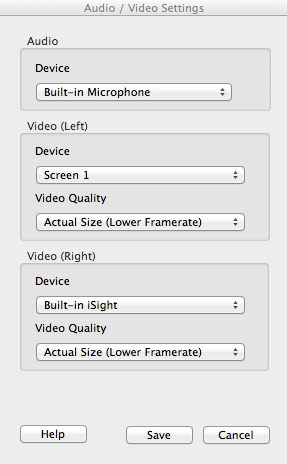...
You use the Audio/Video Devices dialog box to select the devices. The devices you select will be available for you to enable or disable when you begin recording. Say, for example, that you configured the Built-in microphone, Screen 1, and the Built-in iSight web camera. When you are about to begin a recording, each of these devices would be shown at the bottom of the precapture pre-capture page.
You can enable or disable them from the recording screen. (The Built-in iSight camera is disabled in the screen shown.) However, if you do not configure the devices in this procedure, you will not see them listed on the recording screen. You cannot enable or disable them at all.
How Do I Know What Devices to Configure?
In many cases, the devices you select will be fairly simple. Consider these questions when choosing the devices to configure. You can always toggle these on or off before the capture begins if your preferences change.
What data do I want in the recording? Probably the most common configuration is A/V/D: the recording contains audio (your voice), video (your image), and display (a PowerPoint presentation or other screen display). This configuration gives you the ability to have a "talking head" with a slide presentation. It will be displayed within the EchoPlayer as a dual-channel capture.
However, you might just want a simplified A/D capture with only audio and display. This way, if you are camera shy, you can walk through your slide presentation and discuss it, but your image is not recorded.
...
- From the Welcome Screen or My Recordings screen, click Start Recording. This takes you to the precapture pre-capture page.
- In the bottom panel, click Configure.
- The Audio/Video Devices page appears. Review the selections within the dialog box and correct any field as necessary.
- The Device drop-down lists show the devices that are plugged in and registered with the operating system.
- If your device is not listed, exit Personal Capture, plug in your device and restart Personal Capture.Devices not detected by the operating system are not usable by Personal Capture.
- Under Audio, select the recording device from the drop-down list.
- Select the Video (Left) device you will use. You can choose either a capture of the computer screen display, or video input. If you use two visual inputs (either display and video or two video inputs), the data captured with the Video (Left) device appears on the left side of the finished recording. That is, it will be to the left of the data captured by the Video (Right) device.
- To capture your screen display (a PowerPoint presentation or other screen display) select Screen 1 from the Device drop-down list.
- To capture video, select the video input device from the Device drop-down list.
- Select the Video Quality for the Video (Left) input.For a Display input, remember that Actual Size (Lower Framerate) will create the best capture, but requires a large amount of storage and processing time. It also produces large playback files that are slow to load and challenge students' patience. Choose Smaller Size unless you have a strong need for the higher resolution.
- Select the Video (Right) device you will use. The data captured will appear on the right side of the recording. That is, it will be to the right the data captured by the Video (Left) device.
- This device must capture video, using either the built-in camera or another camera you attach. To capture onscreen display items, use the Video (Left) selections noted above.
- The Video Quality drop-down list, shown in the Windows dialog box below, allows you to select Low, Standard or High resolution for the video capture. The higher the resolution, the larger the resulting file will be, and the more time it will take to upload to the server. Selecting Low or Standard resolution is sufficient in most cases. Select High resolution if there are details shown in the video capture that require the highest possible resolution.
- Click Save.
Now you have configured Personal Capture. You can always go back and re-select devices if you change inputs. These inputs appear on your precapture pre-capture page. You can always toggle them on and off from the precapture pre-capture page, changing the inputs for a particular capture.
...
- Insufficient processing power. The sheer amount of data captured by two cameras, especially if the cameras are capturing at high definition, can strain the processing power and internal bandwidth (data transfer) of your computer.
- Mis-sychronizationsynchronization. Differences in camera quality, initialization/start-up startup time, and configuration can cause the two videos to be slightly mis-sychronizedsynchronized.
Follow the tips to minimize these issues.
...




